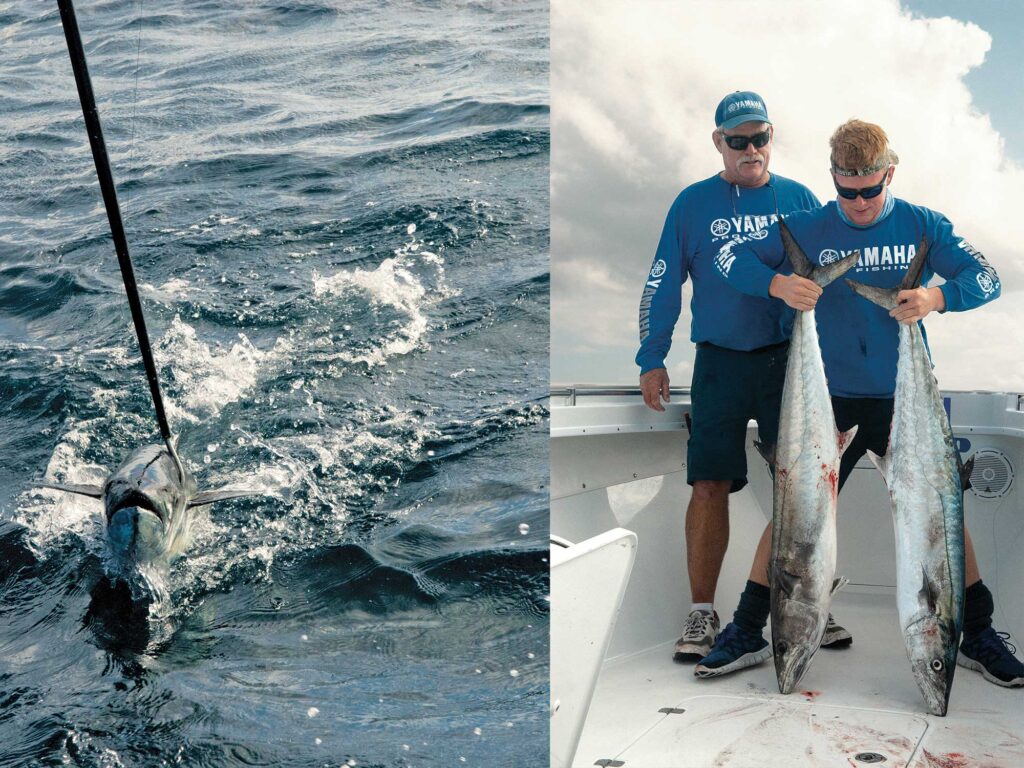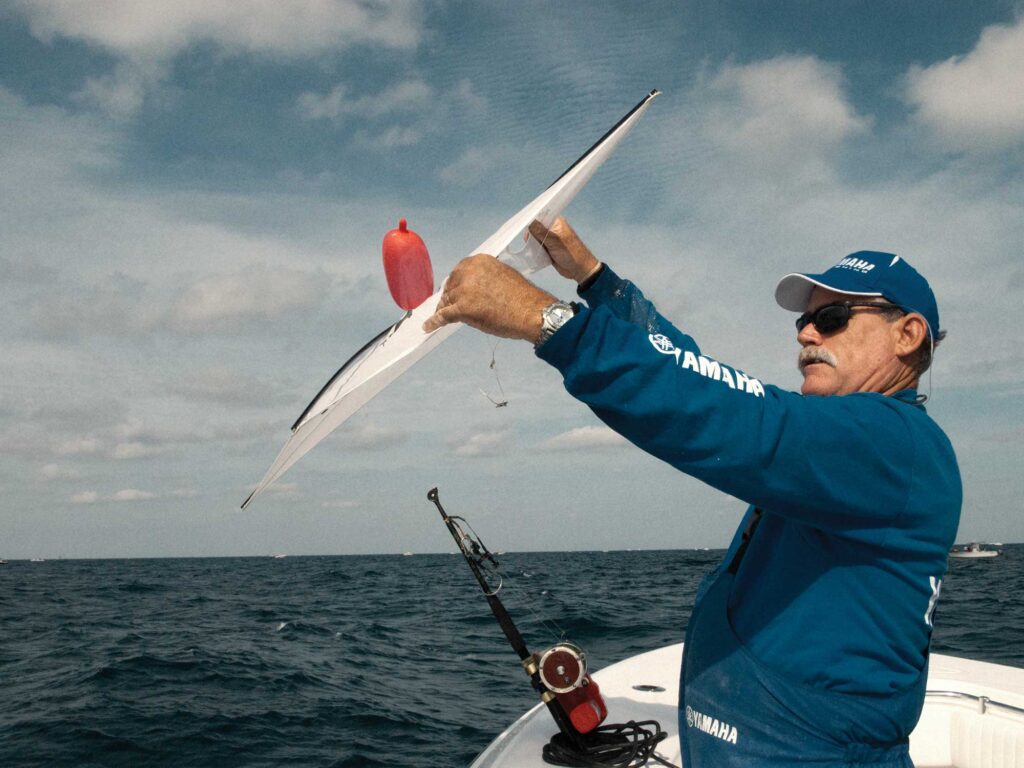SB Television
Expert Tips for Catching King Mackerel
 To catch king mackerel longer than your legs requires preplanning, like studying altimetry charts that show eddies and upwellings.
Gary Caputi
To catch king mackerel longer than your legs requires preplanning, like studying altimetry charts that show eddies and upwellings.
Gary Caputi
When I was working with the Southern Kingfish Association about 15 years ago, I met and befriended Capt. George Mitchell. He would arrive at tournaments in a stunning hauler towing a high-performance center-console, both wrapped in matching blue and white Yamaha graphics. He has maintained that affiliation to this day, serving as the company’s saltwater fishing guru, technical advisor and fishing instructor, helping thousands of anglers up their game.
Mitchell has been a licensed mariner for 37 years. He grew up in Key Largo and South Miami, where he fished for king mackerel as a hook-and-line commercial fisherman and charter captain from a young age. He competed on the SKA tournament trail for more than 20 years with a team that included his son, Eddie, as the junior angler. They won 11 tournaments in the first three years, and Eddie still holds the junior record with a 62.8-pound king. Mitchell moved to Jupiter, Florida, in 2013, and chartered from there and Venice, Louisiana, at various times of the year until he moved to Port St. Joe in the Florida Panhandle in 2017.
He does not fish competitively anymore but is on the water regularly in his latest ride, a Sportsman 302 center-console powered by twin Yamaha F350 outboards with a Helm Master EX digital electronic helm, a system he helped develop and refine. He has fished for kings from Texas to the Tortugas and Key West to North Carolina, and has been involved in creating and popularizing some of the most widely used kingfish techniques.
 If you were part of the 2000s kingfish tournament scene, you likely recognize Capt. George Mitchell’s hauler enveloped in Yamaha graphics.
Gary Caputi
Learn Your Fish
If you were part of the 2000s kingfish tournament scene, you likely recognize Capt. George Mitchell’s hauler enveloped in Yamaha graphics.
Gary Caputi
Learn Your Fish
“With kingfish, as with any fishing, you have to learn as much as you can about the target species,” Mitchell stresses. “An Atlantic kingfish is different than a Gulf kingfish. Sure, they are the same fish, but they are different stocks with different migratory patterns, so that is a good place to start.”
The typical migration pattern of the Atlantic kingfish finds them in the Keys during January and February, off South Florida in March and April, and in northern Florida in May and June. Georgia and South Carolina anglers catch them in July and August, and those in North Carolina into Virginia get their share of fish from September through November. The Gulf stocks have different travels and time tables, but the largest concentrations in the central and eastern Gulf are encountered from August through October. In the western Gulf, from the West Delta to Galveston, Texas, kingfish show strongly from September through November. Their movements are not as predictable as the Atlantic stocks for a variety of reasons.
“The wild cards in the Gulf are the Loop Current and tropical storms that can move baitfish and kings in unpredictable ways,” Mitchell says. “And the Gulf Stream on the Atlantic side can shift a hot bite north in a day’s time.”
But there is a way to factor those variables in and locate prime fishing areas, what Mitchell calls “red zones.”
 A hardtail or goggle-eye dangling at the surface under a kite can drive kingfish crazy.
Gary Caputi
Finding Kings
A hardtail or goggle-eye dangling at the surface under a kite can drive kingfish crazy.
Gary Caputi
Finding Kings
“When I started fishing competitively, I had years of experience that helped with my early success,” Mitchell explains. “Then, 21 years ago, I met Tom Hilton (of Hilton’s Realtime-Navigator) at the Fort Lauderdale boat show, and after many conversations about his information service, I started using it seriously. Over time, working with all the data provided, I came to rely on it as my initial point of reference for planning my fishing. I was doing most of my pre-fishing on my computer, looking for the conditions that would help me find those red zones. When the service was upgraded to include availability on my iPhone, it was a total game-changer.”
Mitchell went on to explain that Hilton’s offers altimetry, chlorophyll, water color, and sea-surface temperature, all displayed on charts overlayed with bathymetric graphics of the known structure spots for each region. The charts are updated after each satellite pass, but one key to getting the most out of the service is the archive feature. It lets you page back through the charts from the prior few days. That makes it possible to identify water movements and trends so you can pinpoint those areas with the greatest possibility of holding baitfish and pelagic predators, including kings.
“Once you start using this detailed information, it will make you a better fisherman,” Mitchell notes. “The learning curve is actually quick. I pay particular attention to the altimetry charts that show eddies and upwellings. Upwellings spawn algae blooms that are clearly shown on the chlorophyll charts. Algae blooms attract baitfish, and the predators are never far behind. Using the archives, you can watch the red zones develop and get a feel for the direction they are moving.”
Mitchell mentions that in regions where there is little major current, structure becomes a critical component in finding fish. He notes areas off South Carolina where he often finds kingfish on the natural and artificial structure abundant there. He also says there are times when bait is closer to the beach, and kings will follow. Pay attention to inlets that provide water movement, especially on the outgoing tide when kings might be holding along nearby ship channels. “I’ve won several kingfish tournaments right outside Government Cut,” he adds. “The strong tidal outflow moves a lot of bait, and the kings would often hover near the ship channel feasting on them.”
The same goes for places where tidal river currents wash nutrients out of large inlets, setting up conditions for a hot bite. The most prominent structure in areas of the Gulf are oil and gas production platforms, places like the Salt Domes off Biloxi, and areas offshore of major outflows that attract menhaden, blue runners, threadfins and kingfish.
 Before fishing, load up on local live baits. A variety of options can be critical. Don’t leave the dock without sabiki rigs and a dehooker.
Gary Caputi
Execute a Plan
Before fishing, load up on local live baits. A variety of options can be critical. Don’t leave the dock without sabiki rigs and a dehooker.
Gary Caputi
Execute a Plan
After doing his research, Mitchell develops a strategy for the day’s fishing. It will include the three most likely spots to fish, which he denotes as his Alpha, Bravo and Charlie destinations. The one with the most favorable conditions will be his first stop, the others his fallback spots.
“Once you have your plan set, the next thing to master is fishing effectively,” Mitchell says. “Always have a selection of rigs made up and easily accessible to cover all the bait types you might use during the day. Your tackle should be in top condition and your reels loaded with high-vis lines with at least 15 feet of 50-pound fluorocarbon leader. I use 30-pound monofilament and set my drags at just 2 pounds.”
Have a plan for securing a supply of live and dead baits prior to heading to your Alpha spot. Have a supply of the most prevalent baitfish found in the area, but also baits of different species and preferably some larger ones. Frequently, baits that do not match the hatch—baits that stand out from the crowd—will catch the biggest kingfish, Mitchell says.
Most fishboats today have two livewells, which make it easier to segregate and take care of different types of baitfish. “I never leave the dock without ribbonfish on ice and several rigged and ready, regardless of where I am fishing,” Mitchell says. “You never want to waste time catching bait when you arrive at a prime spot.”
Mitchell always presents his initial spread moving down-sea toward the red zone; he gets his baits out well before he gets to his initial spot for his first pass. The spread will typically include the biggest and best baits. The approach is bump-trolling at slow speeds. On a boat with a Helm Master digital helm, speed and direction can be controlled with the system’s Speed Control and Pattern Shift features in conjunction with the autopilot.
He deploys the first long bait rigged on a 3-foot wire leader, and if he notices it is swimming faster than the boat’s speed, he will place a small balloon about 10 feet ahead of it to slow it down. It also lets him track the bait’s position. Then he puts out the second long bait with another balloon, if necessary.
The longs are followed by a prop-wash bait about 25 feet directly behind the engines. If the prevalent baitfish are small—say, cigar minnows, menhaden or threadfins—he will use a three-fish rig to create a daisy chain of live baits. The prop-wash bait accomplishes two things: It provides the ability to see if the baitfish are swimming naturally and to make speed adjustments if needed. One of the biggest kingfish I have ever seen was during a tournament out of Georgia’s Golden Isles. It skied on a menhaden in the wash, coming out of the water almost close enough to touch. It was easily 70 pounds.
Read Next: Fishing for King Mackerel on Light Tackle
 Pre-rigged ribbonfish are a prerequisite bait wherever kings swim.
Gary Caputi
Pre-rigged ribbonfish are a prerequisite bait wherever kings swim.
Gary Caputi
The next bait out is run from a downrigger. Mitchell always has two downriggers at the ready. “When fishing shallow, less than 60 feet, I use a single downrigger with the bait placed at 30 feet,” he explains. “When the water is deeper, I use both downriggers and space them at two different depths. I like to clip off a portion of the tail on a downrigger bait to slow it down, making it harder to swim up the line toward the ball and release clip. Not only does it make a mess, but it also screws up the presentation.”
Mitchell points out you only really need those positions in your spread, especially when you are fishing shorthanded or in a wide-open bite. Part of fishing effectively is knowing when you have more rods out than your crew can manage.
If his team is up to it, Mitchell deploys what he calls the bonus baits. Typically, these are fished under a kite. A devoted sailfish guide for many years, Mitchell is an expert at fishing kites and was one of the first tournament captains to employ them for targeting kings. The technique is incredibly effective.
“Having a live blue runner or goggle-eye dancing on the surface can drive a kingfish crazy,” he says. “But a little secret we used is fishing a dead ribbonfish with no weight under the kite so it slithers across the surface. That technique has caught some monster kings, including Eddie’s 62.8-pounder.”
The post Expert Tips for Catching King Mackerel appeared first on Salt Water Sportsman.
- Home
- About Us
- Write For Us / Submit Content
- Advertising And Affiliates
- Feeds And Syndication
- Contact Us
- Login
- Privacy
All Rights Reserved. Copyright 2025, Central Coast Communications, Inc.